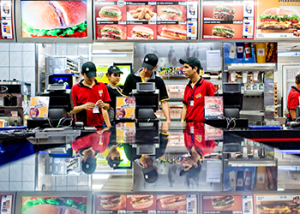There’s no denying that shoppers are spoilt for choice when it comes to payment methods. Card payments, contactless payments, Apps, electronic transfers and even cryptocurrencies mean that consumers now have more choice than ever when it comes to grabbing the mid-morning latte or paying for that post-work pizza. But while consumers enjoy the freedom and choice that cashless payment options provide, the reality of a completely cash free world is a step too far for many. Both retailers and restaurants who’ve made the foray into a cashless business model are meeting big resistance. For cashless restaurants especially, the appetite is waning. But why?
 A cashless business model makes sense at first glance. Eliminating cash handling means a reduction in restaurant operating costs, decreased labor costs, increased efficiency, lower levels of internal and external theft, a reduction in staff stress levels and ultimately an increase in the bottom line. Plus, by going cashless, restaurants can reduce checkout times leaving staff with more time to serve hungry customers.
A cashless business model makes sense at first glance. Eliminating cash handling means a reduction in restaurant operating costs, decreased labor costs, increased efficiency, lower levels of internal and external theft, a reduction in staff stress levels and ultimately an increase in the bottom line. Plus, by going cashless, restaurants can reduce checkout times leaving staff with more time to serve hungry customers.
So why then, are cashless restaurants failing to take off?
It seems that many consumers still want the option of paying in cash. Just last year Shake Shack trialled a cashless business model, rolling out their first cash-free location in the US. Instead of cashiers, Shake Shack employed “hospitality champs” who were available to help customers navigate the “cashless kiosks” used to place orders. But these cashless ordering kiosks were met by resistance from customers, with many going as far as to vent their anger online – highlighting confusing systems, a lack of employee support and a desire to be able to pay in cash. Ultimately the backlash resulted in the restaurant re-instating cashiers alongside the cash-free kiosks and ditching any immediate plans to turn Shake Shack into a cashless restaurant.
Chicago’s Epic Burger went ahead and completely removed the option for cash payments after multiple robberies and security breaches, but later stated that the move towards a cashless business model “generated the most negative pushback of anything we’ve ever done”.
Given the opposition from consumers, it’s not surprising then that many restaurants are reluctant to even trial a cashless approach. Apple-Metro CEO, Zane Tankel, stated that their 30+ Applebee’s franchises will not become cashless anytime soon. Tankel noted that the restaurant business is a service establishment and that refusing to serve a customer who wishes to pay using cash would be nothing short of poor service.
Plus, in an increasingly competitive industry, many restaurants are reluctant to make a move that could drive customers into the arms (and restaurants) of their direct competition.
But it’s not just the restaurants themselves that are putting the brakes on a move towards a cashless business model. Some US states are considering a ban on cashless restaurants in an effort to ensure that businesses don’t discriminate against those who don’t have access to credit, such as children, the elderly or those from low-income backgrounds.
With a move towards a cashless environment seeming doubtful then, how else can restaurants overcome the inefficiencies and additional costs that come with the taking cash as a form of payment?
Enter cash management technology… an umbrella term for a multitude of technologies that all aim to make the process of accepting cash quicker, easier, more efficient and less costly. From cash recyclers, to cash counters, to intelligent cash drawers; cash management technology is helping restaurants to realize many of the same benefits of a cashless business model (improved operational efficiency, reduced costs and a reduction in the time spent managing cash), without alienating their customers.
US Restaurant Chain Panda Express implemented intelligent cash counters to automate manual cash management processes leading to increased efficiency, a reduction in labor costs and an increase in security. The Director of Audit stated that their Tellermate cash counters “not only [provide] accurate and efficient counts for our tills and deposits but it also enhances our security and cash controls”.
Meanwhile, restaurant chain El Pollo Loco recently turned to Smart Safes to streamline the way they process cash payments at the point of sale and in an effort reduce the multitude of costs associated with processing cash. For others, end-to-end solutions, such as LiveDrawer are providing a restaurants with a streamlined and efficient way of managing cash payments whilst virtually eliminating cash loss at the point of sale.
But what about those family-owned franchises, or single-location restaurants who don’t have the deep pockets of their conglomerate competitors?
For these restaurants, inexpensive standalone solutions, such as Touchscreen cash counters, are enabling them to replicate many of the benefits of being cashless, while still giving consumers the option to purchase food with their preferred payment method. Plus, by limiting the time taken for cashiers to count the cash drawer, prepare bank deposits, and complete change audits, these clever devices are automating manual tasks and giving restaurant employees and managers more time to spend with customers.
Ultimately, while the benefits of a cashless business model may be plentiful, the pushback from consumers and opposition from lawmakers, means that the concept of cashless restaurants may never gain mainstream acceptance.
Instead, restaurants should look to optimize their cash management processes from point of sale to bank deposit in order to reduce costs, eliminate inefficiencies and drive a better customer experience.
If you’re seeking to optimize the cash management process in your restaurant, download the “Building a Business Case for Better Cash Management” Ebook to help understand how effective cash management can reduce restaurant operating costs, and increase efficiency.